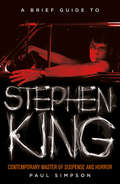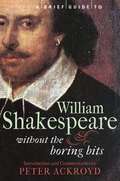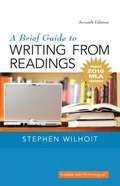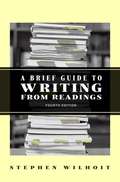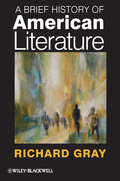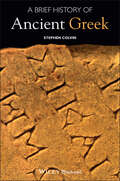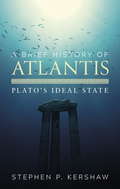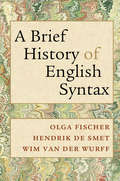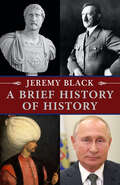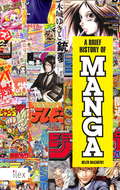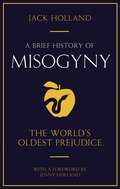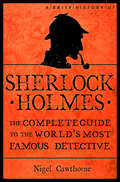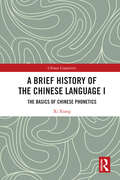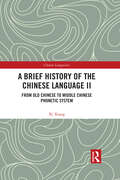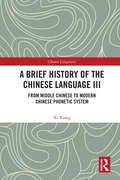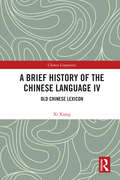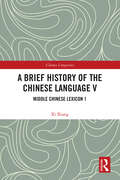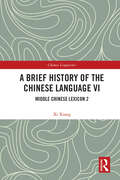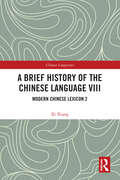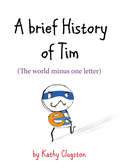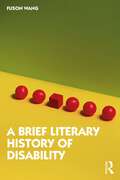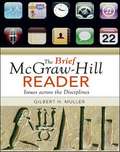- Table View
- List View
A Brief Guide to Stephen King
by Paul Simpson2014 marks the 40th anniversary of the publication of Stephen King?s first novel Carrie in April 1974. Rescued from the rubbish by his wife Tabitha, the novel launched the Maine schoolteacher on a prolific and extraordinarily successful career. His name has become synonymous with horror and suspense through over fifty works, including The Dark Tower, a retelling of Byron?s Childe Harold to the Dark Tower Came.Simpson traces the writer?s life from his difficult childhood ? his father went out to the shops and never came back ? through his initial books under the pseudonym Richard Bachman to the success of Carrie, Salem?s Lot and The Shining in the 1970s, and beyond. He examines how King?s writing was affected by the accident that nearly killed him in 1999 and how his battles with alcohol and addiction to medication have been reflected in his stories. The guide will also take a look at the very many adaptation?s of King?s work in movies, on television and radio, and in comic books.
A Brief Guide to Stephen King (Brief Histories)
by Paul Simpson2014 marks the 40th anniversary of the publication of Stephen King’s first novel Carrie in April 1974. Rescued from the rubbish by his wife Tabitha, the novel launched the Maine schoolteacher on a prolific and extraordinarily successful career. His name has become synonymous with horror and suspense through over fifty works, including The Dark Tower, a retelling of Byron’s Childe Harold to the Dark Tower Came.Simpson traces the writer’s life from his difficult childhood – his father went out to the shops and never came back – through his initial books under the pseudonym Richard Bachman to the success of Carrie, Salem’s Lot and The Shining in the 1970s, and beyond. He examines how King’s writing was affected by the accident that nearly killed him in 1999 and how his battles with alcohol and addiction to medication have been reflected in his stories. The guide will also take a look at the very many adaptation’s of King’s work in movies, on television and radio, and in comic books.
A Brief Guide to William Shakespeare (Brief Histories)
by Peter AckroydAn accessible and entertaining journey through the life, times, and work of the Bard - Enigma. Master of language. The greatest comedian in history? The most famous writer in the world. But isn't he a little bit boring? This is an essential guide for anyone who has previously avoided the Bard, and is the perfect introduction for first time students or seasoned theatre lovers. The book contains a full commentary of all the plays by bestselling and reknowned writer Peter Ackroyd as well as full descriptions of the cast and the drama; not forgetting the best speeches, and the wit and wisdom from across the works. There is also an opportunity to explore the poems and a complete set of sonnets, as well as an investigation of who the dark lady might have been.Contains:The complete sonnets; the greatest speeches; the best lines.Perfect for students struggling through their first play or for theatre lovers anywhere.Entertaining, accessible, Shakespeare without the boring bits.
A Brief Guide To Writing From Readings
by Stephen WilhoitA Brief Guide to Writing from Readings is a clear, process-oriented guide to academic writing. The guide covers the subtleties of rhetorical analysis and argumentation strategies as well as the technical aspects of writing with sources. Students will learn first to examine texts critically and then to clearly, accurately and creatively respond in essay form. In-text tools including summary charts and revision checklists help students tackle source-based essays step by step. Instructors will rely on the guide as a one-stop reference tool; students can apply their learning to any discipline, whether for class work or independent study. <p><p> In the Seventh Edition, in response to student and faculty feedback, Wilhoit includes a new chapter on analyzing readings and composing analytical essays; more coverage of literary analysis and a new short story; eight academic readings; and expanded coverage of how to cite electronic sources in APA and MLA style.
A Brief Guide to Writing from Readings (4th Edition)
by Stephen WilhoitA Brief Guide to Writing from Readings teaches students how to write the most common papers assigned in college courses: source-based essays that summarize, analyze, critique, and synthesize. Comprehensive enough to serve as a primary text yet compact enough to serve as a supplement, this clear and concise writing guide teaches students how to critically read, clearly summarize, carefully respond to, and accurately quote or paraphrase texts. A Brief Guide to Writing from Readings, Fourth Edition, is a valuable teaching and reference tool that students of many disciplines will find useful for course work and for independent study. This text is an excellent teaching tool and reference guide to the most widely used documentation styles. NEW TO THIS EDITION · A new chapter, "Argumentative Synthesis" (Chapter 10), expands coverage of the definition and elements of an argument, including claims, grounds, and warrants. A new chapter, "Rhetorical Analysis" (Chapter 8), reinforces the rhetorical concepts, habituates students to reading and writing rhetorically, and features a rhetorical analysis of President Lincoln's Second Inaugural Address. An expanded chapter on response essays (Chapter 6) includes suggestions for writing thesis statements ("openings") and concluding paragraphs ("closings"), and features sample essays. Two new Appendices, "Peer Review Guidelines" and "Revision Guidelines," offer brief action steps for which A Brief Guide is well known.
A Brief History of American Literature
by Richard GrayA Brief History of American Literature offers students and general readers a concise and up-to-date history of the full range of American writing from its origins until the present day. Represents the only up-to-date concise history of American literature Covers fiction, poetry, drama and non-fiction, as well as looking at other forms of literature including folktales, spirituals, the detective story, the thriller and science fictionConsiders how our understanding of American literature has changed over the past twenty yearsOffers students an abridged version of History of American Literature, a book widely considered the standard survey text Provides an invaluable introduction to the subject for students of American literature, American studies and all those interested in the literature and culture of the United States
A Brief History of Ancient Greek (Wiley Brief Histories of the Ancient World)
by Stephen ColvinA Brief History of Ancient Greek accessibly depicts the social history of this ancient language from its Indo-European roots to the present day. Explains key relationships between the language and literature of the Classical period (500 - 300 BC) Provides a social history of the language which transliterates and translates all Greek as appropriate, and is therefore accessible to readers who know little or no Greek Written in the framework of modern sociolinguistic theory, relating the development of Ancient Greek to its social and political context Reflects the latest thinking on subjects such as Koiné Greek and the relationship between literary and vernacular Greek
A Brief History of Atlantis: Plato's Ideal State (Brief Histories)
by Dr Stephen P. KershawThe Atlantis story remains one of the most haunting and enigmatic tales from antiquity, and one that still resonates very deeply with the modern imagination. But where did Atlantis come from, what was it like, and where did it go to?Atlantis was first introduced by the Greek philosopher Plato in two dialogues the Timaios and Kritias, written in the fourth century BC. As he philosophises about the origins of life, the Universe and humanity, the great thinker puts forward a stunning description of Atlantis, an island paradise with an ideal society. But the Atlanteans degenerate and become imperialist aggressors: they fight against antediluvian Athens, which heroically repels their mighty forces, before a cataclysmic natural disaster destroys the warring states. His tale of a great empire that sank beneath the waves has sparked thousands of years of debate over whether Atlantis really existed. But did Plato mean his tale as history, or just as a parable to help illustrate his philosophy?The book is broken down into two main sections plus a coda - firstly the translations/commentaries which will have the discussions of the specifics of the actual texts; secondly a look at the reception of the myth from then to now; thirdly a brief round-off bringing it all together.
A Brief History of English Syntax
by Olga Fischer De Smet Hendrik Wurff Wim Van DerIn its 1500-year history, the English language has seen dramatic grammatical changes. This book offers a comprehensive and reader-friendly account of the major developments, including changes in word order, the noun phrase and verb phrase, changing relations between clausal constituents and the development of new subordinate constructions. The book puts forward possible explanations for change, drawing on the existing and most recent literature, and with reference to the major theoretical models. The authors use corpus evidence to investigate language-internal and language-external motivations for change, including the impact of language contact. The book is intended for students who have been introduced to the history of English and want to deepen their understanding of major grammatical changes, and for linguists in general with a historical interest. It will also be of value to literary scholars professionally engaged with older texts.
A Brief History of History
by Jeremy BlackIn A Brief History of History, acclaimed historian Jeremy Black seeks to reinvigorate and redefine our ideas about history. The stories we tell about the past are a crucial aspect of all cultures. However, while the traditional storytelling process—what we think of as "history" in the proper sense—is useful, it is also misleading, not least because it leads to the repetition of bias and misinformation. Black suggests that the conventional idea of history and historians is constructed too narrowly, as it fails to engage with the broad nature of lived experience. By focusing on a singular idea or story within the history being explored, we fail to understand the interconnectivity of the everyday experience. A Brief History of History challenges accepted norms of the historical perspective and offers a view of human history that will surprise many and (perhaps) infuriate some. But above all, it is a history of historians written for this moment in time, a time when the traditional Eurocentric approach to history now appears wholly inappropriate.
A Brief History of Manga: The Essential Pocket Guide To The Japanese Pop Culture Phenomenon
by Helen MccarthyManga is more than a genre in the comics field: it is a vital creative medium in its own right, with hundreds of millions of readers worldwide, a host of graphic styles, and a rich history now spanning seven decades. Now for the first time, that history is told by an award-winning expert in the field. Covering topics from Akira to Mazinger Z, this book is fully illustrated throughout, and photos of key creators accompany accessible sidebars and timelines. The text is chronological, telling the story of Manga from its early-20th-century origins to its global dominance. Timelines relate key publications to events in Japanese and World history, and frequent sidebars give short biographies of key creative figures. Answering the key questions of any fan - where did my favourite manga come from, and what should I read next? - this book will open doors to neophytes and experts alike. Fans of manga and anime will: - discover the stories behind their favorite manga creator - be inspired by the history of the medium and its genre - find new manga to read and fall in love with
A Brief History of Misogyny: The World's Oldest Prejudice
by Jack HollandIn this compelling, powerful book, highly respected writer and commentator Jack Holland sets out to answer a daunting question: how do you explain the oppression and brutalization of half the world's population by the other half, throughout history? The result takes the reader on an eye-opening journey through centuries, continents and civilizations as it looks at both historical and contemporary attitudes to women. Encompassing the Church, witch hunts, sexual theory, Nazism and pro-life campaigners, we arrive at today's developing world, where women are increasingly and disproportionately at risk because of radicalised religious belief, famine, war and disease. Well-informed and researched, highly readable and thought-provoking, this is no outmoded feminist polemic: it's a refreshingly straightforward investigation into an ancient, pervasive and enduring injustice. It deals with the fundamentals of human existence -- sex, love, violence -- that have shaped the lives of humans throughout history. The answer? It's time to recognize that the treatment of women amounts to nothing less than an abuse of human rights on an unthinkable scale. A Brief History of Misogyny is an important and timely book that will make a long-lasting contribution to the efforts to improve those rights throughout the world.
A Brief History of Misogyny: The World's Oldest Prejudice (Brief Histories)
by Jack HollandIn this compelling, powerful book, highly respected writer and commentator Jack Holland sets out to answer a daunting question: how do you explain the oppression and brutalization of half the world's population by the other half, throughout history? The result takes the reader on an eye-opening journey through centuries, continents and civilizations as it looks at both historical and contemporary attitudes to women. Encompassing the Church, witch hunts, sexual theory, Nazism and pro-life campaigners, we arrive at today's developing world, where women are increasingly and disproportionately at risk because of radicalised religious belief, famine, war and disease. Well-informed and researched, highly readable and thought-provoking, this is a refreshingly straightforward investigation into an ancient, pervasive and enduring injustice. It deals with the fundamentals of human existence -- sex, love, violence -- that have shaped the lives of humans throughout history. The answer? It's time to recognize that the treatment of women amounts to nothing less than an abuse of human rights on an unthinkable scale. A Brief History of Misogyny is an important and timely book that will make a long-lasting contribution to the efforts to improve those rights throughout the world.
A Brief History of Sherlock Holmes
by Nigel CawthorneCreated by Sir Arthur Conan Doyle in 1887, Sherlock Holmes appears in four novels and fifty-six short stories. Although Holmes was not the first literary detective, he continues to have a perennial allure as the ultimate sleuth. As Holmes is being re-introduced to a new audience through TV and film, Cawthorne introduces the general reader to Holmes and his creator Arthur Conan Doyle. He gives a full biography of author as well as his creation, including his resurrection following his unlikely death at the hands of arch enemy, Moriarty. Cawthorne also surveys the world of Holmes, looking at Victorian crime, the real characters behind Dr Watson and Inspector Lestrade, as well as the world on the doorstep of 22b Baker Street.
A Brief History of Sherlock Holmes (Brief Histories)
by Nigel CawthorneCreated by Sir Arthur Conan Doyle in 1887, Sherlock Holmes appears in four novels and fifty-six short stories. Although Holmes was not the first literary detective, he continues to have a perennial allure as the ultimate sleuth. As Holmes is being re-introduced to a new audience through TV and film, Cawthorne introduces the general reader to Holmes and his creator Arthur Conan Doyle. He gives a full biography of author as well as his creation, including his resurrection following his unlikely death at the hands of arch enemy, Moriarty. Cawthorne also surveys the world of Holmes, looking at Victorian crime, the real characters behind Dr Watson and Inspector Lestrade, as well as the world on the doorstep of 22b Baker Street.
A Brief History of the Chinese Language I: The Basics of Chinese Phonetics (Chinese Linguistics)
by Xi XiangAs the first volume of a multi-volume set on Chinese phonetics, this book gives a full picture of the historical development of the Chinese language and studies the phonetics of the early form of Chinese, i.e. Old Chinese.Chinese language history is generally split into three phases: 1) Old Chinese, the form of the Chinese language spoken between the 18th century BC and the 3rd century AD, 2) Middle Chinese, between the 4th century AD to around the 12th century AD, and 3) Modern Chinese, since the 13th century. In this volume, the author first introduces basic issues in Chinese language study, including research objectives, methodology, existing scholarship, periodization, and the distinctive linguistic characteristics of each period. The core chapters then describe and analyze the phonetical systems of Old Chinese, covering the initials system and related eight aspects, two types of rhyme groups, ancient finals, and the tonal system.This comprehensive groundwork on Chinese phonetical history will be a must read for scholars and students studying Chinese language, linguistics and especially for those wishing to become acquainted with Old Chinese phonetics.
A Brief History of the Chinese Language II: From Old Chinese to Middle Chinese Phonetic System (Chinese Linguistics)
by Xi XiangAs the second volume of a multi-volume set on Chinese phonetics, this book examines the phonetical systems of Middle Chinese and phonetical changes from Old Chinese to Middle Chinese.Chinese language history is generally split into three phases: 1) Old Chinese, the form of the Chinese language spoken between the 18th century BC and the 3rd century AD, 2) Middle Chinese, between the 4th century AD to around the 12th century AD, and 3) Modern Chinese, since the 13th century. This volume studies the phonological system of Middle Chinese, including the initials system, finals system, and tonal system, examining the evolution of these systems from the period of Old Chinese to that of Middle Chinese.This comprehensive groundwork on Chinese phonetical history will be a must read for scholars and student studying Chinese language, linguistics and especially for beginning learners of Middle Chinese phonetics.
A Brief History of the Chinese Language III: From Middle Chinese to Modern Chinese Phonetic System (Chinese Linguistics)
by Xi XiangAs the third volume of a multi-volume set on Chinese phonetics, this book examines the phonetical system of Modern Chinese and phonetical changes from Middle Chinese to Modern Chinese.Chinese language history is generally split into three phases: (1) Old Chinese, the form of the Chinese language spoken between the 18th century BCE and the 3rd century CE, (2) Middle Chinese, between the 4th century AD to around the 12th century CE, and (3) Modern Chinese, since the 13th century. This volume studies the phonetical systems of Modern Chinese, including the initials system, vowel final system, nasal final system, entering final system, and tonal system. The author discusses the distinct change of these systems from the period of Middle Chinese to that of Modern Chinese and studies the formation of the standard pronunciation of the common language of the modern Han nation.This comprehensive groundwork on Chinese phonetical history will be a must read for scholars and student studying Chinese language, linguistics, and especially for beginning learners of Modern Chinese phonetics.
A Brief History of the Chinese Language IV: Old Chinese Lexicon (Chinese Linguistics)
by Xi XiangAs the fourth volume of a multi-volume set on the Chinese language, this book studies the lexical system of Old Chinese and the development of different types of lexicons during the period. Focusing on lexicons in Old Chinese, the early form of the Chinese language used between the 18th century BCE and the 3rd century CE, this volume first introduces the methods of word formation in Old Chinese by analyzing words inscribed in oracle bones of the Shang Dynasty. Illustrated with examples, it then examines the lexical features of Old Chinese and explores the progress and evolutionary features of monosyllabic words, polysyllabic words, lexical meanings, synonyms, and idioms and proverbs over the course of the volume.This comprehensive groundwork on Chinese lexical history is a must-read for scholars and students studying ancient Chinese language, linguistics, and especially for beginning learners of the Old Chinese lexicon.
A Brief History of the Chinese Language V: Middle Chinese Lexicon 1 (Chinese Linguistics)
by Xi XiangAs the fifth volume of a multi-volume set on the Chinese language, this book studies the development of monosyllables and polysyllables in Middle Chinese and the overall evolution of lexical meanings during the period.Focusing on lexicons in Middle Chinese, the Chinese language used between the 4th century AD and the 12th century AD, the book first introduces the monosyllabic neologisms of Middle Chinese, including characters and words derived from Old Chinese lexicons and those newly created. It then examines the development of polysyllabic words in Middle Chinese, ranging from single morpheme words, tautologies and compound words. The final chapter discusses the changes and extension of word meanings in medieval Chinese.Illustrated with abundant examples, this comprehensive groundwork on Chinese lexical history will be a must read for scholars and students studying ancient Chinese language, linguistics and especially for beginning learners of the Middle Chinese lexicon.
A Brief History of the Chinese Language VI: Middle Chinese Lexicon 2 (Chinese Linguistics)
by Xi XiangAs the sixth volume of a multi-volume set on the Chinese language, this book studies the influence of foreign culture on Middle Chinese lexicon and the development of synonyms, idioms and proverbs during the period.Focusing on lexicons in Middle Chinese, the middle form of the Chinese language used between the 4th century AD and the 12th century AD, this book first analyzes loanwords in Middle Chinese, a product of cultural exchange with western regions on the silk road and the impact of Buddhism. It then discusses the differences in meaning between monosyllables and polysyllables. The final chapter describes enriching idioms and proverbs and the major sources of words, including classical works, Buddhist texts and the spoken language.Illustrated with abundant examples, this comprehensive groundwork on Chinese lexical history will be a must read for scholars and students studying ancient Chinese language, linguistics and especially for beginning learners of the Middle Chinese lexicon.
A Brief History of the Chinese Language VIII: Modern Chinese Lexicon 2 (Chinese Linguistics)
by Xi XiangAs the final volume of a multi-volume set on the Chinese language, this book studies the Western and Japanese influence on the lexicon of Modern Chinese, lexical developments in synonyms, idioms and proverbs in modern times, and lexical developments in contemporary times.This volume first introduces the influence of foreign cultures on the modern Chinese lexicon with an emphasis on loanwords from Japanese and Indo-European languages. It then discusses the synonyms, idioms and proverbs of Modern Chinese, elucidating their evolution, sources and composition. The final part centers on the development of the Chinese lexicon after the May 4 Movement in 1919, marking the beginning of the contemporary phase of the Chinese language. The author analyses trends and types of neologisms and loanwords and analyzes the blend of Mandarin and dialect words as well as the necessity of lexical standardization.Illustrated with abundant examples, this comprehensive groundwork on Chinese lexical history will be a must read for scholars and students studying modern Chinese language, linguistics and especially for beginning learners of modern and contemporary Chinese lexicon.
A Brief History of Tim: The World Minus One Letter
by Kathy ClugstonRather than explaining our origins, A Brief History of Tim addresses our history and culture at the levelwe most deeply desire - the trivial. By simply removing one letter, the world is tweaked with immensely enjoyable results:For those who think contemporary art is a load of rubbish, there's the Tat Modern. Find out about the Ancient Geeks, nerdy types who spent far too much time doing maths.A Brief History of Tim is laugh-out-loud funny and will have you looking at the world through fresh eyes.
A Brief Literary History of Disability
by Fuson WangA Brief Literary History of Disability is a convenient, lucid, and accessible entry point into the rapidly evolving conversation around disability in literary studies. The book follows a chronological structure and each chapter pairs a well-known literary text with a foundational disability theorist in order to develop a simultaneous understanding of literary history and disability theory. The book as a whole, and each chapter, addresses three key questions: • Why do we even need a literary history of disability? • What counts as the literature of disability? • Should we even talk about a literary aesthetic of disability? This book is the ideal starting point for anyone wanting to add some disability studies to their literature teaching in any period, and for any students approaching the study of literature and disability. It is also an efficient reference point for scholars looking to include disability studies approaches in their research.
The Brief McGraw-Hill Reader: Issues across the Disciplines
by Gilbert H. MullerSupporting a liberal arts tradition in the classroom, across the curriculum, and beyond, The Brief McGraw-Hill Reader offers rich and diverse readings in education, the social sciences, business and economics, the humanities, and the sciences.
